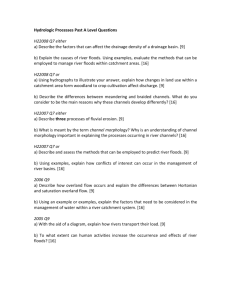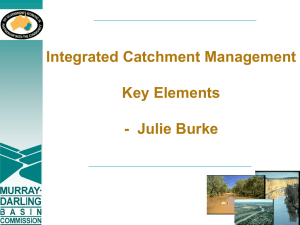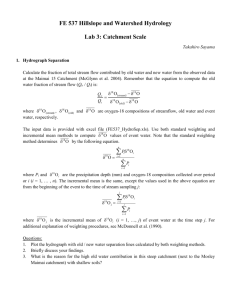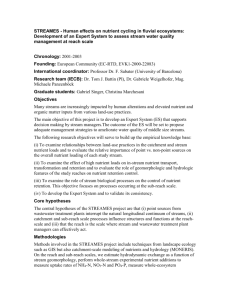STREAM HYDROLOGY AND LAND COVER ASSESSMENT IN
advertisement
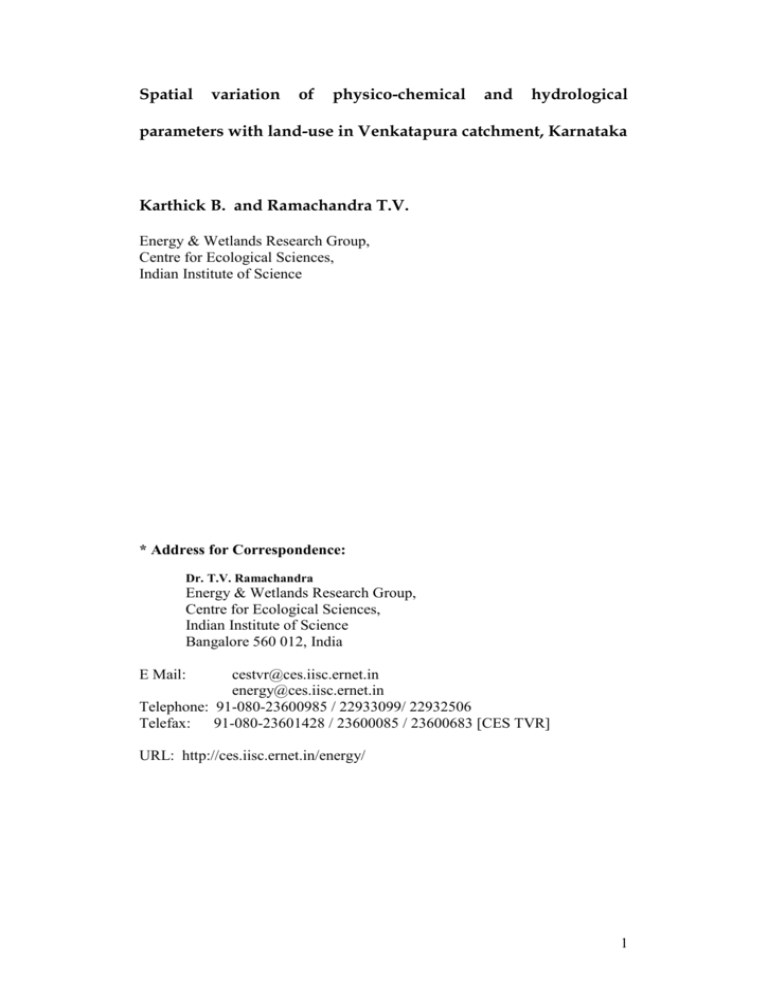
Spatial variation of physico-chemical and hydrological parameters with land-use in Venkatapura catchment, Karnataka Karthick B. and Ramachandra T.V. Energy & Wetlands Research Group, Centre for Ecological Sciences, Indian Institute of Science * Address for Correspondence: Dr. T.V. Ramachandra Energy & Wetlands Research Group, Centre for Ecological Sciences, Indian Institute of Science Bangalore 560 012, India E Mail: cestvr@ces.iisc.ernet.in energy@ces.iisc.ernet.in Telephone: 91-080-23600985 / 22933099/ 22932506 Telefax: 91-080-23601428 / 23600085 / 23600683 [CES TVR] URL: http://ces.iisc.ernet.in/energy/ 1 Spatial variation of physico-chemical and hydrological parameters with land-use in Venkatapura catchment, Karnataka ABSTRACT Social, economic and political development of a region is dependent on the health and quantity of the natural resources. Integrated approaches in the management of natural resources would ensure sustainability, which demands inventorying, mapping and monitoring of resources considering all components of an ecosystem. The monitoring of hydrological and catchment landscape of river resources have a vital role in the conservation and management of aquatic resources. This paper presents a case study Venkatapura river basin in Uttara Kannada district of Karnataka State, India based on stream hydrology and landuse analyses. The results revealed variations in dissolved oxygen and free carbon dioxide according to the flow nature of the water, and increased amount of phosphates and coliform contamination in streams closer to anthropogenic activities. Keyword: Stream Hydrology, Venkatapura, Land-use, Water Quality, Uttara Kannada 2 INTRODUCTION Rivers are the most important freshwater resource for humans. Social, economic and political development has, in the past, been largely related to the availability and distribution of freshwater riverine systems (Chapman, 1996). In recent years intensive agricultural and other developmental activities to meet the needs of the escalating population have affected the surface and ground water sources at an alarming rate all over the country. Water quality, quantity and safety have become major issues in public and environmental health. This necessitates immediate measures to manage the water resources. In this regard, regular water quality assessment helps to elucidate the quality and appropriate mitigation measures. (Prasad, et al., 2003) Studies pertaining to river ecological status monitoring of South Indian rivers like Godavari, Krishna and Tungabhadra (Mitra, 1982), Cauvery (Ganapati, 1955 Somasekar, 1983, 1985; Anvar Batcha, 1998), Kapila (Ganapati, 1955; Somasekar, 1984), Malampuzha (Chacko et al., 1953) and Tamabaraparani (Ganapati, 1956) have received an attention for the last five decades. However, information on water quality of west flowing rivers in Karnataka is meager. Though some information is available on general limnological features of selected few streams (Anonymous, 1995) detailed water quality studies of all the rivers are not available. Uttara Kannada district of Karnataka, India has the distinction of having good natural forest cover (>70%) with large number of perennial to small seasonal streams. Most of these rivers and streams originate in the Western Ghats and joins finally the Arabian Sea. 3 In addition to the natural heterogeneity in the physical characteristics of the catchment, the distribution and disposition of different land uses may hugely influence catchment’s response by modifying the connectivity and continuity of drainage lines (Schulze, 2000). The integrated aquatic ecosystem management requires proper study for sound understanding and effective management of water systems and their internal relations (Ramachandra, et al., 2005), and hence an attempt has been done in the present study to determine the spatial variation of physico-chemical and hydrological parameters with respect to land-use in Venkatapura river catchment. STUDY AREA The Venkatapura river is located between 13.98° - 14.15° N and 74.48°- 74.73° E in the southern part of Uttara Kannada district of Karnataka, India (Figure 1). It originates in Western Ghats and confluence into Arabian Sea after a course of 45 km near Venkatapura with a catchment of 335 km2 (Kamath, S.U., 1985). Forest and agriculture are the major land use in the catchment. The river basin is divided in to six sub basins namely Venkatapura tributary, Chitihalla, Katagar Nala, Basti Halla, Kitrehole and Venkatapura river (Figure 2) based on major tributaries. 4 MATERIAL AND METHODS In order to assess the spatial variation of water quality in the river basin, 11 sampling stations were identified (Table 1, Figure 1) and sampling was carried out during post monsoon. Physico-chemical variables were analysed according to APHA, 1985 and Trivedy and Goel, 1986. Streams network in the catchment was digitized based on Survey of India toposheets (1:50, 000) using GIS software. Based on this layer, hydrological parameters like drainage density, catchment area, stream density and stream length were computed. Land use analysis was done with the LISS – Data of IRS 1C remote sensing data (of 04 January 2004) using supervised classification based on the maximum likelihood classifier (MLC) with ILWIS 3.1 Image processing software. RESULTS AND DISCUSSION The results of water quality analysis are shown in Table 2. The relative humidity in the atmosphere was high in upstream (56 – 71 %) when compared with that of downstream (42 – 68 %). The pH of the stream water ranges within 6.65 - 7.81, which indicates the neutral condition of water. The variables related to ionic content of the water (electrical conductivity, total dissolved solids, alkalinity and chlorides) were recorded in lower concentration. The concentration of free carbon dioxide ranges from 6.16 to 52.8 mg/L in the whole stretch. The high amount of carbon dioxide was recorded in site 2 and 6 (44.59 and 52.8 respectively) due to the stagnation of water in the streams. Total hardness ranges from 8.53 to 32 mg/L with mean calcium and magnesium hardness of 3.92 and 14.93 mg/L respectively. The highest amount of 5 total hardness was recorded from the site 6, which has human interference. Among the factors regulating DO in streams, three primary processes are air-water exchanges, photosynthesis, and respiration. Different land-use may alter the relative importance of photosynthesis and respiration (Wilcock, 1986; Quinn et al, 1992; Young and Huryn, 1999). In this study low levels of dissolved oxygen was recorded in sites having stagnant water (2, 3, 5 and 11) and flowing water bodies were well aerated, which is revealed in high dissolved oxygen values of 6 – 9.27mg/L. Nitrates ranged from below detectable level to 0.13 mg/L. Streams in the upstream recorded high amount of nitrates when compared to those at downstream. Organic and inorganic forms of phosphorous contribute to the total phosphorous of the aquatic environment, due to natural weathering, soil erosion, agricultural runoff, biological transfer and use of soluble phosphate compounds as detergents. In the present study the total phosphates ranges from 0.1 – 0.22 mg/L and the highest amount of phosphates were recorded at site 6, where the agricultural runoff and activities like bathing and washing clothes occurs in the stream bank. Sulphate values ranged from 9 – 13.5 mg/L with mean value of 11.15mg/L. The mean value for sodium and potassium was 8.19 and 0.90 respectively. Most sampling sites showed presence of Coliform contamination, which shows the human interference in aquatic system. All the parameters measured were within Indian standards specifications for drinking water (IS 10500 – 1983). Land-use analysis (results are in table 3) shows that the evergreen forest is the major land-use category covering 39.75%, followed by horticultural crops (areca, coconut, 6 cashew) and agricultural lands, covering nearly 33.19% (111.23 sq.km). The other main land-uses are deciduous forests covering an area of 29.53 sq.km, exotic plantation accounts 21.4 sq.km (6.39%) and teak plantation 14.92 sq.km (4.45%). Hydrological parameters in the catchment are listed in table 4. Overlaying land-use (Figure 3) with stream network layer (Figure 1), indicates that the catchments dominated by evergreen to semi-evergreen type of vegetation have higher stream orders and density. CONCLUSION Land-use analyses with catchment hydrologic parameters indicate that, the catchments dominated with evergreen-semi evergreen type of forests have higher stream density and most of the streams are perennial compared to catchments dominated by anthropogenic influences. The variation in dissolved oxygen and free carbon dioxide is due to stagnant or flowing nature of the water body. The variation in phosphates and coliform is due to the anthropogenic activities in the catchment. The catchment area is mainly covered with forest and agricultural lands. The streams drain from agricultural area showed high phosphates value, reflecting that land-use linkage with the stream water quality. The water quality of the river is free of contaminants and serves as a suitable habitat for aquatic plants and animals 7 ACKNOWLEDGEMENT: The Ministry of Science and Technology, Government of India provided the financial assistance to carry out field investigations. We thank Lakshminarayana, and Vishnu for assistance during the field investigations. We are grateful to Gururaja, K. V., Sreekantha, Sameer Ali and Shruthi, B.V. for useful suggestions during discussions REFERENCES 1) Anonymous, 1995. Water Quality - Status and Statistics. Central Pollution Control Board. New Delhi. 2) Anvar Batcha S M, 1998. Studies on hydrography and domestic pollution problems in the north bank of river Cauvery, J. Environ. Poll. 5 (1), 69-71. 3) APHA, 1985, Standard methods for the examination of water and wastewater, 16th ed. American Public Health Association, American Water Works Association, Washington, DC, USA. 4) Chacko P I, Srinivasan R and Evangeline G, 1953. Hydrobiology of the Malampuzha river with reference to development of fisheries in the Malampuzha reservoir, Ind. Comm. J., Madras 8 (1): 118-124. 5) Chapman D, Edi, 1996. Water Quality Assessment: A Guide to the Use of Biota, Sediments and Water in Environmental Monitoring, Second Edition, Chapman and Hall, London, UK. 6) Ganapati S V, 1955. Hydrobiological investigations of the Stanley reservoir and of the river Cauvery at Mettur Dam, Meteorological Chemistry 6: 1-8. 8 7) Ganapati S V, 1956. Hydrobiological investigations of the Hope reservoir and the Thambaraparani river at Papanasam, Tirunelveli District, Madras State, Indian Geogr. J. 31: 1-20. 8) Kamath S U, 1985. Gazetteer of India, Karnataka state gazetteer, Uttara Kannada District, Government of Karnataka Publication, Bangalore. 9) Mitra A K, 1982. Chemical characteristics of surface water at selected gauging stations in the river Godavari, Krishna and Tungabhadra, Indian J. Environ. Health, 24, 165-179. 10) Prasad S. N., Sengupta T., Alok Kumar, V. S. Vijayan, Lalita Vijayan, Ramachandra T. V., Ahalya N. and Tiwari A. K, Wetlands of India. (Ed) Venkataraman, K. 2003, Natural Aquatic Ecosystems of India: Thematic Biodiversity Strategy and Action Plan, The National Biodiversity Strategy Action Plan, India. 11) Quinn M, Williamson R B, Smith R Kand Vickers M L, 1992. Effects of riparian grazing and channelisation on streams in Southland, New Zealand. 2. Benthic invertebrates, New Zealand J. Mar. Freshwat. Res. 26, pp. 259–273. 12) Ramachadra T V, Ahalya N and Rajasekara Murthy C., 2005. Aquatic Ecosystems: Conservation, Restoration and Management, Capital Publishing Company. New Delhi. 13) Schulze, R. (2000). Transcending scales of space and time in impact studies of climate and climate change on agro-hydrological responses. Agriculture, Ecosystems and Environment, 82, 185–212. 9 14) Somasekar, R K, 1983. Algal flora of river Cauvery, Karnataka – I, Cyanophyceae and Chlorophyceae, Phycos 22: 73-80. 15) Somasekar, R K, 1985. Studies on water pollution of River Cauvery: Physicochemical Characteristics, Int. Envron. Stud, 23, 115-124. 16) Trivedy R. K. and Goel P. K., 1986. Chemical and Biological Methods for Water Pollution Studies, Environmental Publications, Karad. 17) Wilcock R J, 1986. Agriculture runoff: a source of water pollution in New Zealand, N.Z. Agric. Sci. 20, pp. 98–103. 18) Young R G and Huryn A D, 1999. Effects of land use on stream metabolism and organic matter turnover, Ecol. Appl. 9 4 (1999), pp. 1359–1376. 10 Figure 1 – Location of sampling sites along the River Venkatapura. Figure 2 – Sub basins of River Venkatapura Figure 3 – Landuse and landcover classification of Venkatapura River Basin. Table 1 - Sampling Sites names and respective number of Venkatpura River Basin. Table 2 - Results of variables registered at downstream sampling sites of River Venkatapura (All parameters are in mg/L except mentioned; WT- Water temperature, AT – Air temperature, RH – Relative humidity, DO – Dissolved Oxygen, BDL – Below Detectable Level, P – Present, A- Absent) Table 3 - Landuse and landcover classification of Venkatapura River Basin Table 4 - Hydrological parameters of Venkatapura River Basin 11 Figure 1 : Venkatapura with streams network (and sampling sites). 12 Figure 2: Sub basins in River Venkatapura Figure 3: Land-use classification of Venkatapura River Basin. 13 Table 1: Sampling Site at Venkatapura River Basin. Site No. Site Name Site No. Site Name 1 Badabhag 7 Ondalasu 2 Undlakatle 8 Hegganamakki 3 Midal 9 Kurandura 4 Arkala 10 Bachohodi 5 Galibyle 11 Kelanur 6 Nagolli 14 Table 2: Physico-chemical parameters at downstream sampling sites Site No 1 2 pH 6.88 7.81 EC (µS) 44 TDS 7 8 9 7.05 7.05 6.90 7.24 6.81 6.65 6.98 7.36 6.73 33.67 39.33 51 54 46.33 58.67 69 54 40 22 16.67 19.33 25.67 21.67 26.33 23.00 29.33 34.33 26.33 20.00 WT(°C) 27.43 33.13 27.93 27.40 28.83 30.80 26.90 33.33 23.77 29.17 25.57 AT(°C) 30.67 33.40 28.33 34.23 32.27 31.83 28.60 32.67 21.00 29.33 26.67 RH (%) 52 52.00 68 65 73 56 66 CO2 10.27 44.59 6.16 8.80 7.63 9.97 15.55 8.51 13.20 Alkalinity 25.64 22.44 30.13 21.79 24.36 22.44 21.79 21.15 42.95 28.20 26.28 Chlorides 11.15 10.01 10.65 10.01 10.79 10.51 10.30 12.00 9.59 9.66 8.84 Hardness 18.40 8.53 11.20 16.53 17.87 32 20.00 27.73 20.00 19.60 Calcium 3.37 2.67 1.82 4.92 3.63 1.76 6.36 5.61 4.81 Magnesium 15.03 5.86 9.38 11.62 14.23 27.83 11.51 18.24 21.37 14.39 14.79 DO 8.34 5.04 5.72 9.27 5.56 5.37 6.00 7.63 6.82 7.96 4.28 Nitrates 0.01 0.03 0.05 0.01 0.04 BDL 0.13 0.12 0.09 0.06 0.04 Phosphates 0.08 0.08 0.12 0.12 0.06 0.22 0.10 0.17 0.14 0.15 0.15 Sulphates 9.61 11.65 9.02 11.26 10.47 11.26 12.45 12.15 9.00 12.21 13.52 Sodium 8.13 6.72 7.63 8.48 7.78 8.59 8.13 8.53 9.95 8.48 7.73 Potassium 0.82 0.39 0.49 0.78 0.87 1.16 0.87 1.99 1.07 0.87 0.53 Coliform A P P P P P P Note: P 3 4 47 P 5 44 63 P 6 46 71 52.80 12.91 15.47 4.17 3.95 P 10 11 (All parameters are in mg/L except mentioned; WT- Water temperature, AT – Air temperature, RH – Relative humidity, DO – Dissolved Oxygen, BDL – Below Detectable Level, P – Present, A- Absent) 15 Table 3: Land-use categories in Venkatapura river catchment Land-use classes Area sq.km Area (%) Agriculture/Fallow Land 35.69 10.65 Areca/Coconut/Cashew 75.54 22.54 Exotic Plantation 21.4 6.39 Teak Plantation 14.92 4.45 Evergreen Forest 133.19 39.75 Deciduous Forest 29.53 8.81 6.6 1.97 Settlements 3.14 0.94 Open/Barren Land 12.6 3.76 Sand\Oyster\Dry River Bed 1.2 0.36 Water Bodies 1.3 0.39 Scrub Savanas/Grasslands 16 Table 4 - Hydrological parameters of Venkatapura River Basin No of Streams Total Streams Catchment (stream orderwise) length (km) Area Total Stream Drainage Streams Density Density (sq.Km) Sub basins 2 3 4 5 75 11 3 1 0 46.88 16.05 90 5.61 2.92 Katagar Nala 124 26 3 4 0 86.7 28.01 157 5.61 3.10 Venkatapura 753 158 30 7 2 593.7 147.7 950 6.43 4.02 Kitrehole 1 a b c c/b a/b Tributary Venkatapura 30 9 3 1 0 30.12 26 43 1.65 1.16 88 18 4 1 0 85.95 32.46 111 3.42 2.65 439 102 23 3 1 317.6 79.43 568 7.15 4.00 River Basti Halla Chitlihalla 17



